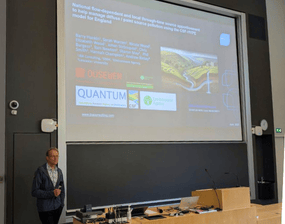Rising waters | Rooted solutions
Sharing NFM insights at LuWQ2025 and University of Manchester

Ousewem’s evidence base is attracting growing attention from academic, practitioner, and policy audiences. This spring, two members of our team shared insights from our work at major events.
Ousewem’s evidence base is attracting growing attention from academic, practitioner, and policy audiences. This spring, two members of our team shared insights from our work at major events, helping to highlight the role of natural flood management (NFM) and source apportionment modelling in building long-term catchment resilience.
Barry Hankin presented Ousewem as a case study at the prestigious Land Use and Water Quality (LuWQ2025) conference in Aarhus, Denmark, in June. Meanwhile, Adam Johnston delivered a guest lecture at the University of Manchester, introducing students to real-world applications of modelling, monitoring, and catchment management.
Ousewem on the international stage: LuWQ2025
LuWQ2025 is one of the leading international conferences exploring the relationship between land use and water quality. Barry presented Ousewem as a case study, showcasing national and local examples of through-time source apportionment and flow-dependent pollution risks, including case studies from Arkengarthdale and the Fieldmouse platform.
Barry highlighted how Ousewem is using tools like Fieldmouse and HYPE to improve understanding of pollutant half-lives at field scale and support upscaling across wider catchments. These models are helping to assess where nature-based solutions (NbS) can be most effective, combining risk and opportunity mapping to inform targeted interventions.
His presentation also introduced a new way to measure the impact of catchment interventions: peak mass avoided. This approach mirrors the use of peak flow avoided in flood modelling, offering a clear picture of how different measure perform under varying flow conditions.
“The Fieldmouse risk maps and through-time plots from Arkengarthdale show what is possible when you combine good modelling with real-world monitoring data,” Barry reflected. “It was great to be able to share Ousewem’s approach internationally and see how much interest there is in practical, evidence-led catchment management.”
Supporting the next generation: University of Manchester guest lecture
In March, Adam Johnston spoke to undergraduate geography students at the University of Manchester about how evidence-led tools are shaping modern flood and catchment management. On their second-year hydrology course, students have been learning about natural flood management and how it is an important tool not only for flood risk management, but in a catchment-based approach to water management. As a guest speaker in the lecture, Adam talked about careers in hydrology after university and the importance of research skills - specifically for evidence-based decision making in flood risk management, using Ousewem’s monitoring for modelling work as an example of this.

“It was fantastic to see how engaged the students were in in the link between modelling, monitoring and real-world decision making,” Adam said. “It’s encouraging to think this kind of engagement might help inspire the next generation of water and environmental professionals.”
Why sharing our work matters
For Rachel Flood, Ousewem’s project manager, participating in events like LuWQ2025 and the Manchester lecture is an important part of building Ousewem’s wider impact.
“By sharing our learning more widely, we are not only showcasing the value of natural flood management and evidence-led decision making, we are helping to inspire future collaborations, inform policy, and open up new investment opportunities for nature-based solutions,” Rachel said. “Academic and practitioner networks are vital to embedding Ousewem’s impact for the long term.”
As Ousewem continues to develop its research and demonstration projects across Yorkshire, building strong links with national and international partners remains key to achieving a more resilient, nature-positive future.
Also see

